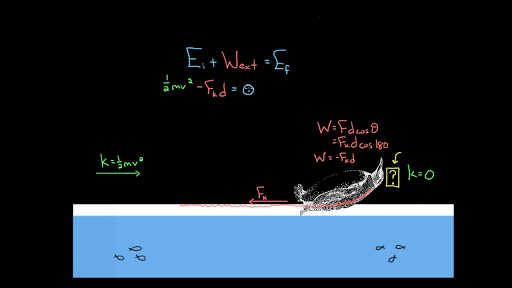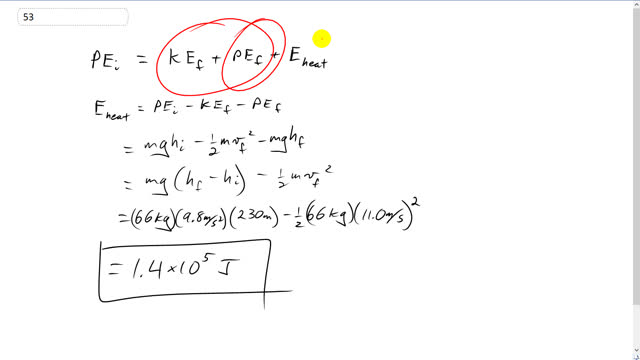12 m v2 5 20 132 169 Joules so 628 - 17 611 Joules went into heating up the slide. The energy dissipated due to friction can be written as E.

Thermal Energy Work Done By Friction Youtube
A block of mass m is sliding down an inclined plane with constant speed.

. Find the amount of energy E dissipated by friction by the time the block stops. Is energy dissipated by friction the same as work done by friction where the equation is Wfriction Ff d cos theta. A How much energy Btu is dissipated as heat by the friction of the braking process.
The skier is moving 11ms. Thermal energy is due to the two surfaces ie Walters fur and the ice rubbing against each other which is basically friction. Hence the dissipated energy is.
Energy is usually lost by heating up the surroundings though sometimes energy is dissipated as sound. Click hereto get an answer to your question 001 11 D block of mass m sliding down an incline at constant speed is initially at a heighth above the ground as shown in the figure above. Well how much energy was lost to friction.
I Hope i was clear enough. How much energy was dissipated due to. P lost I 2 R 7410 2 A 2 8 Ω 4410 6 W.
Express your answer to two significant figures and include the appropriate units. A 24 kg child descends a 50 m high slide and reaches the ground with a speed of 28 ms. I mean this energy is lost or dissipated due to.
At the bottom the skier is moving 11 ms. Answers and Replies Mar 1 2010 2 PhanthomJay. A 66-kg skier starts from rest at the top of a 1200-m long trail which drops a total of 230 m from top to bottom.
P P delivered P lost 17410 5 kW. Part A A How much energy was dissipated by friction. B Suppose that throughout the United States 300000000 such braking processes occur in the course of a given day.
The energy dissipated by normal damping is much less significant. Calculate the average rate megawatts at which energy is being dissipated by the resulting friction. Potential at start m g h 20 32 g 64 g 64981 628 Joules How much Kinetic energy was left at the bottom.
A 66-kg skier starts from rest at the top of a 1200-m-long trail which drops a total of 290 m from top to bottom. How much energy was dissipated by friction. A 24 kg child descends a 50 m high slide and reaches the ground with a speed of 28 ms.
If the mass continues to slide down the incline at a constant speed how much energy is dissipated by friction by the. How much energy was dissipated due to. So the work done by friction is W-Fkd Fk is the force of friction and it is equal to the thermal energy.
In the total event most of the energy was dissipated by friction between the support and the bricks red 662 and friction between bricks dark orange 242. This energy is dissipated as heat via friction. B Suppose that throughout the United States 300000000 such braking processes occur in the course of a given day.
Incidentally if it wasnt for that pesky friction the skier would have been doing about 214kmhr at the bottom. At the bottom the skier is moving 110 ms. On calculation we obtained the sliding friction mu is equal to 076.
At a certain instant t 0 its height above the ground is h and coefficient of kinetic friction between the block and the inclined plane is μIf the block reaches the ground at a later instant t g then the energy dissipated by friction in the time interval t g t 0 is. That is the friction force the slide distance 611 Ff 32sin 20 Ff 32 342. The final kinetic energy of the chest assuming that it is initially at rest is the difference between the work done by the pirate and the energy dissipated as heat.
98 of the generated power is delivered to the city. The ways in which energy is dissipated depends on the system. A How much energy Btu is dissipated as heat by the friction of the braking process.
Calculate the average rate megawatts at which energy is being dissipated by the resulting friction. Is equal to the force multiplier with the distance which forces acting minus both. So we have the mass 66 kilograms times 98 meters per second squared times 230 meters fall minus one-half to 66 kilograms times your final speed 11 meters per second squared and thats 14 times 10 to the 5 joules of energy dissipated by friction.
But the actual velocity is 11ms and the actual kinetic energy is mv22 66x121 2 3993 J. Express your answer in terms of some or all the variables m v and h and any appropriate constants. The power dissipated by the wires is I 2 R so the lower the current the lower is the amount of energy per second dissipated by the wires.
The fact that is negative indicates a loss of energy by the chest. Much energy was dissipated due to friction in the process. A 56-kg skier starts from rest at the top of a 1200-m-long trail which drops a total of 230 m from top to bottom.
However since work is the transfer of energy and not energy itself then i. Since friction is a nonconservative force that removes energy from the child earth system mechanical energy is not conserved E T E B All mechanical energy at top is in the form of UgB All mechanical energy at bottom is in the form of K Energy lost is due to friction v B 2gh v B 2xs 14xs 0 5m. So energy lost to friction is 1165428 - 3993 1125498 J.
The coefficient of kinetic friction between the mass and the incline is u. How much energy was dissipated by friction. Now let us determine the energy dissipated due to friction.
Do a pie chart analysis of this situation. Because this is law.

Giancoli 7th Edition Chapter 6 Problem 53 Giancoli Answers
0 Comments